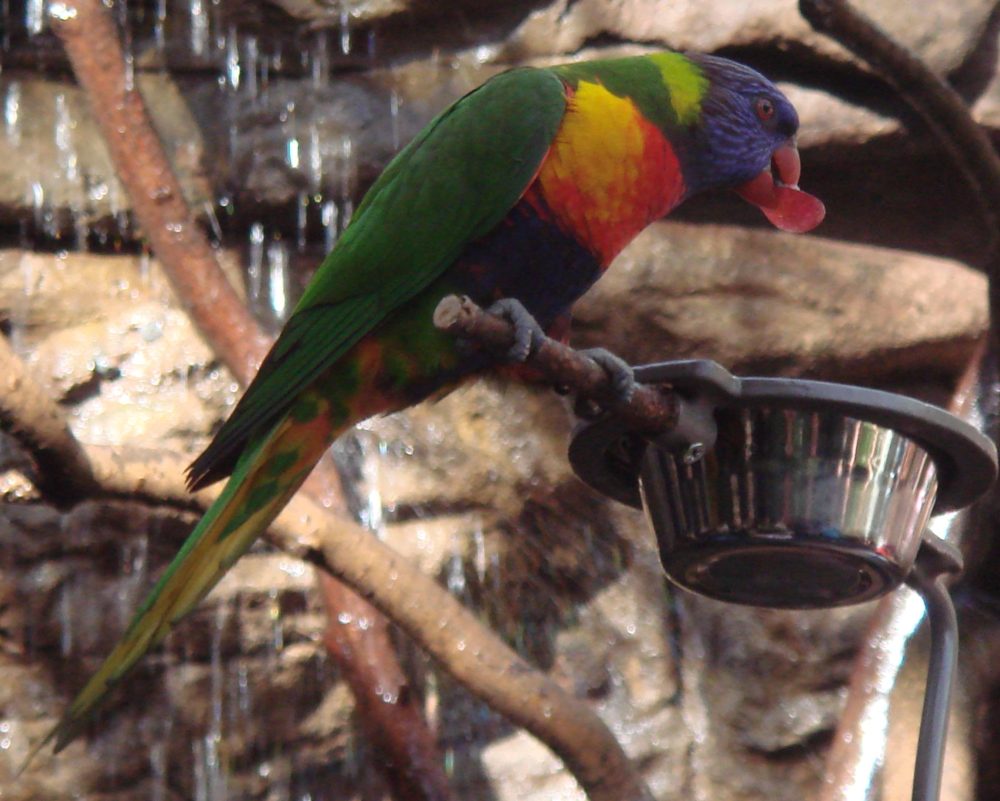By Neena Bhandari
Sydney, 30.07.2001 (WFS): A mysterious and devastating polio-like virus is affecting Rainbow Lorikeets in Australia. The bright hued, gregarious bird with a distinguishing blue head is unable to stand, fly or perch on contacting the disease.
Similar to Poliomyelitis or infantile paralysis in humans where a virus affects the nervous tissue, in the birds too, part of the nervous system is affected causing symptoms of paralysis.
With virtually nothing known about the `suspected viral polioencephalomyelitis’ in the birds, Dr Rosemary Booth, a veterinarian at the University of Queensland in Brisbane and Dr Karrie Rose, a pathologist at the Taronga Zoo in Sydney are carrying out intensive research to unravel the mysterious virus affecting the Rainbow Lorikeets.
Found in coastal forests to urban gardens, noisy flocks of up to several hundreds can be seen congregating in flowering trees to feed and roost. In many Sydney homes, they are as common as Mynahs in Delhi.
Wildlife experts warn that with birds and humans vying for urban space depleting habitat and food resource could be contributing to the disease.
As Dr Booth says, “The fact it’s causing disease in populations close to humans suggests we may be contributing to their susceptibility. Habitat change or another environmental factor associated with humans may be stressing the birds and leaving their immune system weak. When disease becomes prevalent in a population it may indicate problems with the environment which may eventually impact humans”.
The 30 cm tall and weighing about 125 grams, a Rainbow Lorikeet also happens to be the most popular bird kept in Australian aviculture. Easy to tame, a Rainbow Lorikeet is a constant source of amusement. As playful as a kitten, their favourite trick is to sleep lying on their back with feet up in the air, looking rather dead, until the scream of horror wakes them up and they bounce to their feet.
Several thousand are sold each year with a mature pair in Queensland selling for around $90 and a hand reared bird costing about $125.
Dr Booth’s research shows that suspected viral disease is usually found in adult birds living in poor condition. She first started work on the Lorikeets’ disease in 1995 at the Currumbin Sanctuary in South-East Queensland, where up to four per cent of the total number of Rainbow lorikeets rescued each year i.e. 300 to 400 per annum are affected with the clinical `clenched claws syndrome’.
“The exact number of those affected from the total population is difficult to estimate as studies have been done only on lorikeets around Currumbin sanctuary. In the past years, little progress has been made in finding the cause of the disease, which has remained at a fairly constant low level,” says Dr Booth, who has been working as a zoo veterinarian for the past 12 years.
About 10 birds suffering from the crippling paralysis are brought to the Taronga Zoo clinic in Sydney each year. Post‑mortem examinations reveal the birds have inflammation of the spinal cord and brain grey matter, but it appears whatever is causing these fatal symptoms is attacking the part of the brain that controls co‑ordination.
Dr Karrie Rose, a veterinary pathologist for the Zoological Parks Board of NSW and Curator of the Australian Registry of Wildlife Health says, “Investigations into the `clench claw syndrome’ in Rainbow Lorikeets began as far back as 1985. The NRMA Wildlife Clinic at Taronga Zoo admits more than a thousand native animals each year for care and rehabilitation, a significant proportion of them are Rainbow Lorikeets”.
“We see similar legions to the polioencephalomyelitis virus, but at the moment it could be anything,” she adds.
A post-mortem of 35 lorikeets with this clinical condition between 1994 and 1997 revealed that 37 per cent of them had suspected viral polioencephalomyelitis. The condition affects 10 per cent of the rescued Rainbow Lorikeets annually, thereby representing a significant disease of the wild population.
The numbers of Rainbow Lorikeets has not diminished because they are prolific breeders, with pairs known to rear as many as three successive broods in a single season (August to January). A Rainbow Lorikeet lays two eggs and the incubation takes 24 days. The babies fledge at around 56 to 60 days and the young become independent after another 14 days. Sexual maturity is at 18 to 24 months.
Dr Booth suggests measures like planting more nectar bearing plants, stopping felling of hollow bearing trees where they nest and ensuring that suitable roosting trees are available for the flocks to sleep at night could be means to curb the further spread of the disease.
Rainbow Lorikeets primarily feed on pollen, nectar and fruits. She feels it is better not to feed wild birds artificial diets for both nutritional and hygienic reasons. “Communities can help by planting habitat corridors of locally indigenous plants that will benefit a wide range of wildlife and ultimately ourselves. Flowering plants and a regularly cleaned birdbath or pond is a better way of encouraging them to the garden.”
Both Dr Booth and Dr Rose are committed to discover the virus and save one of Australia’s most beautiful bird species.
Dr Booth, who now nurtures her four-year-old daughter along with pursuing her part-time career says, “Whether it was working as a zoo veterinarian or giving lectures at Nepal’s Chitwan National Park, I have always had a keen interest in nature and wildlife. There is so much still unknown about the health of our wildlife that seldom a day goes without discovering a new mystery to solve”.
For Dr Rose, a graduate with a gold medal from the Western College of Veterinary Medicine, Saskatchewan and Doctor of Veterinary Science in Zoo and Wildlife Medicine and Pathology from the Ontario Veterinary College, Canada, “I chose to pursue pathology rather than continue doing clinical veterinary medicine because of the opportunity to investigate wildlife health and disease. There is a sense of discovery and achievement when you are able to identify new disease causing agents and further understand the interactions between disease causing agents and their wildlife hosts.”
Rainbow Lorikeets are native only to Australia.
© Copyright Neena Bhandari. All rights reserved. Republication, copying or using information from neenabhandari.com content is expressly prohibited without the permission of the writer and the media outlet syndicating or publishing the article.



